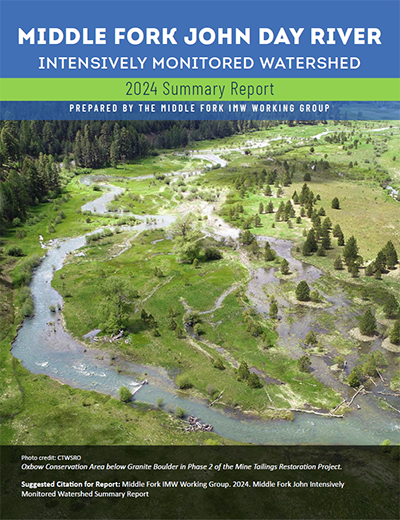Overview
An Intensively Monitored Watershed (IMW) is an intensive watershed-scale research and monitoring effort. While a project-level effectiveness monitoring study might include a single restoration action implemented in several locations across the state, an IMW looks at an entire suite of restoration actions at a larger watershed scale. It achieves the level of sampling intensity necessary to evaluate the biological and physical responses to a set of management and restoration actions.
IMWs are designed to answer questions such as:
- Does the collective effect of restoration and/or management actions result in an improved watershed condition or population parameter of interest? Why or why not?
- What are the causes of responses to restoration and/or management actions?
- Are certain combinations of restoration and/or management actions more effective than others at delivering the intended responses?
Middle Fork John Day River IMW
Background
OWEB in conjunction with tribal entities, state and federal agencies, and private organizations began an Intensively Monitored Watershed (IMW) in the upper Middle Fork of the John Day River. This IMW is aimed at determining the combined effects of different types of restoration actions on the physical and biological functions and processes of a watershed. The idea of an IMW requires a large amount of coordination from the constituents that are completing restoration and subsequent monitoring of these actions.
Middle Fork John Day River Website
Project Summary
In 2008, data collection began. Initial monitoring activities were focused around Steelhead and Chinook salmon, stream temperature, riparian condition, and stream channel morphology. Socio-economic indicators were added in 2009.

2024 Summary Report
A Summary Report was completed in August 2024 that builds off the 10-Year Summary Report completed in 2017. This report represents additional years of work and voluntary reporting by numerous agencies and individuals, conducting restoration, research, and monitoring activities in the upper Middle Fork John Day River. On a voluntary basis, principal investigators and their co-authors wrote individual reports, describing their recent research and findings. Eight contributed reports were compiled, along with pertinent background information, a restoration inventory and assessment of how lessons learned and recommendations were addressed since 2017.
2024 Middle Fork John Day River IMW Summary Report
10-Year Final Summary Report
A Final Summary Report was completed in December 2017 that summarizes data collected from 2008 to 2016. This report represents 10 years of work by numerous agencies, organizations, and individuals conducting restoration, research, and monitoring activities in the upper Middle Fork John Day River. An extensive overview of MFIMW activities, key findings, and recommendations can be found in the Executive Summary.
For full details about a specific monitoring project including methods, analyses and results, readers can refer to Appendices B-M, which are compiled in a separate document. Links, bookmarks, and navigation have been provided, where possible, to ease in viewing this document electronically.
MFIMW Final Report
Appendices B-M
Physical Habitat Monitoring
In 2019, 15 sites in the MFJDR and 10 sites in Camp and Lick creeks were resampled that were originally sampled in 2008/2009 and resampled in 2014 to track watershed scale stream habitat condition changes following the Pacfish/Infish Biological Opinion Effectiveness Monitoring Program (PIBO) sampling methods. For full detail on sampling results for this monitoring effort access the
PIBO Final Report that was completed in 2021.
2017-2020 Monitoring Accomplishments Report
Since completion of the 10-Year Final Summary Report we have continued with restoration and monitoring efforts that are supported from a variety of funding sources. From 2017-2020 partners have implemented over 25 restoration projects within the MFIMW Study Area. Monitoring methods have been adapted and updated based on our findings. The
2017-2020 Accomplishments Report summarizes current monitoring results over this time-period.
Contact
Please direct questions or comments to
Ken Fetcho, Effectiveness Monitoring Coordinator, 971-345-7018.